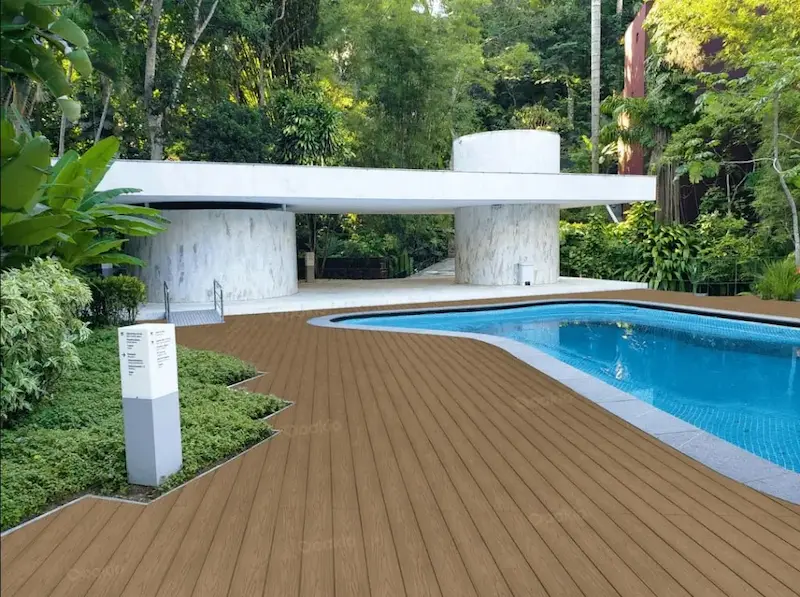Table of Contents
When I started planning my outdoor space, picking the right decking felt overwhelming. With so many composite options out there, I quickly realized it’s not just about durability—it’s about finding something that fits your style and budget.
Importance of Choosing the Right Composite Decking Boards
Selecting composite decking boards affects your outdoor space’s durability, appearance, and functionality. I once picked a budget-friendly option that clashed with my home’s exterior. The result? It was a deck I wasn’t proud of, prompting an expensive replacement later. Compatibility with your style and weather resistance are critical.
Cheaper boards, like hollow ones, may suit short-term projects but lack the strength of solid-core options. To make eco-conscious choices, look for boards with a high recycled material content. Comparing warranties helps identify reliable products. A clear plan avoids regret and wasted costs.
Factors to Consider
Choosing composite decking boards involves balancing practical needs and personal preferences. These considerations help maximize style, durability, and cost-effectiveness.
Aesthetics
Look for composite decking boards that complement your home’s design. Earth tones or grays often pair well with various exteriors. I once picked a bold color that clashed with my patio furniture, so I had to repaint the space. Texture matters, too—some boards mimic natural wood with grooves, while others offer smoother finishes. Use samples to visualize how they’ll appear in your outdoor space.
Durability and Maintenance
Select decking boards that are highly resistant to scratches, UV fading, and moisture. High-performance composite decking often contains protective caps that reduce cleaning needs. Boards without capping absorb more water, leading to warping. Periodic rinsing with water maintains composite surfaces longer than untreated decking materials. Check warranties to estimate lifespan.
Budget
Compare options by calculating the cost per square foot, including installation fees. Some premium decking boards may start at $15 per square foot, while budget options can range closer to $7-$10. I once saved by purchasing on sale during the off-season. Look for discounts on overstocked styles to find affordable choices without compromising quality.
Climate and Environmental Factors
Match composite decking boards to your local weather. In wet climates, boards with slip-resistant finishes reduce hazards from rain. Heat-reflective decking minimizes discomfort in sunny areas. Boards made with recycled materials provide eco-friendly benefits. Read product details to evaluate their suitability for sun exposure, snow, or daily temperature fluctuations.
Types of Composite Decking Materials
Choosing composite decking boards means evaluating material types for performance and style balance. I once picked uncapped boards for a shaded area, thinking their natural look would fit perfectly, but they quickly weathered, teaching me that practicality matters as much as appearance.
Capped vs. Uncapped Composite Decking
The core difference lies in the protective covering. Capped boards have a durable shell, while uncapped ones expose raw composite material. Choosing between them depends on climate and maintenance preferences.
Capped Composite
Capped boards feature a polymer coating that resists moisture, scratches, and stains. This makes them easier to clean and suitable for homes in humid or rainy climates. They also retain color well, preventing fading from UV rays.
Uncapped Composite
Uncapped boards offer a more natural, wood-like appearance but lack the protective layer. This makes them prone to moisture absorption, fading, and staining over time, especially in harsh environments. These boards work best in spaces with minimal exposure to weathering elements.
Other Material Options
Choosing composite decking boards is just one route; other materials bring distinct benefits depending on preferences and requirements.
PVC Decking
PVC decking boards are fully synthetic and offer excellent moisture resistance. This material works well for areas exposed to heavy rain or humidity. One drawback is its smooth surface, which can feel less natural compared to composite alternatives. However, modern designs often mimic wood grain for improved aesthetics.
I once considered PVC for its durability but found its cost higher than composite options per square foot. It’s ideal if low maintenance and longevity outweigh budget restrictions. PVC boards are also lightweight, making installation easier.
Aluminum Decking
Aluminum decking stands out for its unmatched strength and longevity. Corrosion resistance is a significant advantage, making it suitable for coastal or high-moisture regions. While it’s not as visually warm as wood or composites, powder-coated finishes offer various styles.
During a windstorm, I saw a friend’s aluminum deck withstand flying debris with zero damage. Aluminum decking is pricier upfront but proves cost-effective long-term. It is also fire-resistant, slip-resistant, and completely recyclable, adding environmental points to its list of benefits.
Installation Considerations
Choosing composite decking boards isn’t only about style and durability—installation factors also play a key role in creating a safe and stable deck.
Weight and Support
Composite decking boards are heavier than wood or PVC, requiring a well-built frame. I learned this firsthand when my contractor flagged my original frame as too weak to support composite materials. Upgrading to appropriate joists and beams avoided potential sagging or failures later. For optimal support, joist spacing should typically be 16 inches in the center, though local building codes might differ. Always verify the specifications provided by the decking manufacturer.
Fasteners and Spacing
The right fasteners and maintaining proper spacing are critical for a long-lasting deck.
Recommended Fasteners
Hidden fasteners create a clean surface free of visible screws, allowing composite boards to expand or contract naturally. Stainless steel or coated screws prevent corrosion and work best with these materials. Pre-drilling might be needed depending on the product specifications.
Proper Spacing
Adequate gaps between boards prevent buckling during temperature changes. Most composite decking boards call for a 1/8- to 3/16-inch gap, while end-to-end gaps depend on board length and climate. When spacing, always account for seasonal expansion.
Joint Staggering
Staggering board joints helps distribute weight evenly and improves the deck’s appearance. When all joints align in one row, the decking can look unbalanced or weaken under concentrated loads. I’ve seen decks fail prematurely because builders skipped this crucial step. Proper staggering alternates joint placement every row or two, adding strength and style to the deck design.
Conclusion
Choosing composite decking boards means balancing style, durability, and budget without compromising functionality. I once picked a board based solely on cost, only to replace it later because it didn’t match my home or endure wear. Comparing materials, checking samples in natural light, and reviewing warranties avoid these regrets.
Want to explore something different? How to Achieve Glowing Skin: Expert Tips and Tricks

